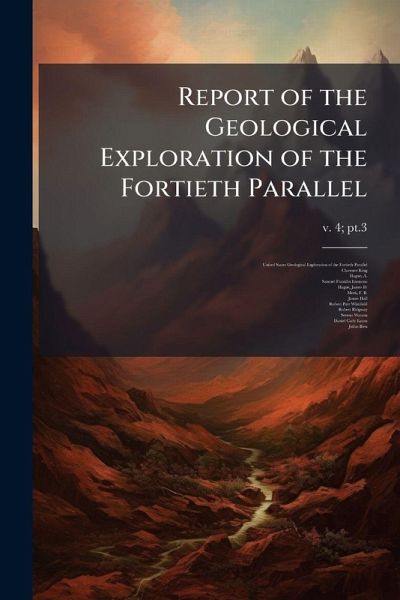
Report of the Geological Exploration of the Fortieth Parallel
Versandkostenfrei!
Versandfertig in über 4 Wochen
24,99 €
inkl. MwSt.
Weitere Ausgaben:

PAYBACK Punkte
12 °P sammeln!
This is Volume 4, Part 3 of the "Report of the Geological Exploration of the Fortieth Parallel", a comprehensive survey conducted by the United States Geological Exploration between 1867 and 1881. Led by Clarence King and featuring contributions from prominent geologists, paleontologists, and naturalists of the era, including Hague, Emmons, Meek, Hall, Whitfield, Ridgway, Watson, Eaton and Bien, this volume offers detailed insights into the geology and natural history of the American West along the 40th parallel. The report provides invaluable primary source material for researchers and anyone...
This is Volume 4, Part 3 of the "Report of the Geological Exploration of the Fortieth Parallel", a comprehensive survey conducted by the United States Geological Exploration between 1867 and 1881. Led by Clarence King and featuring contributions from prominent geologists, paleontologists, and naturalists of the era, including Hague, Emmons, Meek, Hall, Whitfield, Ridgway, Watson, Eaton and Bien, this volume offers detailed insights into the geology and natural history of the American West along the 40th parallel. The report provides invaluable primary source material for researchers and anyone interested in the geological formation, mineral resources, and paleontological discoveries made during this formative period in American scientific exploration. The detailed observations, maps, and illustrations within this report capture a pivotal moment in the understanding of the American landscape and its natural resources. This work has been selected by scholars as being culturally important, and is part of the knowledge base of civilization as we know it. This work was reproduced from the original artifact, and remains as true to the original work as possible. Therefore, you will see the original copyright references, library stamps (as most of these works have been housed in our most important libraries around the world), and other notations in the work. This work is in the public domain in the United States of America, and possibly other nations. Within the United States, you may freely copy and distribute this work, as no entity (individual or corporate) has a copyright on the body of the work. As a reproduction of a historical artifact, this work may contain missing or blurred pages, poor pictures, errant marks, etc. Scholars believe, and we concur, that this work is important enough to be preserved, reproduced, and made generally available to the public. We appreciate your support of the preservation process, and thank you for being an important part of keeping this knowledge alive and relevant.


